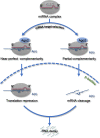The current landscape of microRNAs (miRNAs) in bacterial pneumonia: opportunities and challenges
- PMID: 35986232
- PMCID: PMC9392286
- DOI: 10.1186/s11658-022-00368-y
The current landscape of microRNAs (miRNAs) in bacterial pneumonia: opportunities and challenges
Abstract
MicroRNAs (miRNAs), which were initially discovered in Caenorhabditis elegans, can regulate gene expression by recognizing cognate sequences and interfering with the transcriptional or translational machinery. The application of bioinformatics tools for structural analysis and target prediction has largely driven the investigation of certain miRNAs. Notably, it has been found that certain miRNAs which are widely involved in the inflammatory response and immune regulation are closely associated with the occurrence, development, and outcome of bacterial pneumonia. It has been shown that certain miRNA techniques can be used to identify related targets and explore associated signal transduction pathways. This enhances the understanding of bacterial pneumonia, notably for "refractory" or drug-resistant bacterial pneumonia. Although these miRNA-based methods may provide a basis for the clinical diagnosis and treatment of this disease, they still face various challenges, such as low sensitivity, poor specificity, low silencing efficiency, off-target effects, and toxic reactions. The opportunities and challenges of these methods have been completely reviewed, notably in bacterial pneumonia. With the continuous improvement of the current technology, the miRNA-based methods may surmount the aforementioned limitations, providing promising support for the clinical diagnosis and treatment of "refractory" or drug-resistant bacterial pneumonia.
Keywords: Bacterial pneumonia; Host–pathogen; Off-target effect; Sensitivity; Specificity; miRNA.
© 2022. The Author(s).
Conflict of interest statement
The authors declare that they have no competing interests.
Figures




Similar articles
-
Computational analysis of microRNA targets in Caenorhabditis elegans.Gene. 2006 Jan 3;365:2-10. doi: 10.1016/j.gene.2005.09.035. Epub 2005 Dec 13. Gene. 2006. PMID: 16356665
-
MiRNATIP: a SOM-based miRNA-target interactions predictor.BMC Bioinformatics. 2016 Sep 22;17(Suppl 11):321. doi: 10.1186/s12859-016-1171-x. BMC Bioinformatics. 2016. PMID: 28185545 Free PMC article.
-
Prediction of microRNA targets in Caenorhabditis elegans using a self-organizing map.Bioinformatics. 2011 May 1;27(9):1247-54. doi: 10.1093/bioinformatics/btr144. Epub 2011 Mar 21. Bioinformatics. 2011. PMID: 21422073
-
Functional genomic, computational and proteomic analysis of C. elegans microRNAs.Brief Funct Genomic Proteomic. 2008 May;7(3):228-35. doi: 10.1093/bfgp/eln024. Epub 2008 Jun 19. Brief Funct Genomic Proteomic. 2008. PMID: 18565984 Review.
-
Identification of miRNAs and their targets in C. elegans.Adv Exp Med Biol. 2014;825:431-50. doi: 10.1007/978-1-4939-1221-6_12. Adv Exp Med Biol. 2014. PMID: 25201113 Review.
Cited by
-
Causal relationship between air pollution and infections: a two-sample Mendelian randomization study.Front Public Health. 2024 Aug 1;12:1409640. doi: 10.3389/fpubh.2024.1409640. eCollection 2024. Front Public Health. 2024. PMID: 39148655 Free PMC article.
-
miRNA expression signatures induced by pasteurella multocida infection in goats lung.Sci Rep. 2024 Aug 23;14(1):19626. doi: 10.1038/s41598-024-69654-3. Sci Rep. 2024. PMID: 39179681 Free PMC article.
-
Mechanism of KLF2 in young mice with pneumonia induced by Streptococcus pneumoniae.J Cardiothorac Surg. 2024 Sep 2;19(1):509. doi: 10.1186/s13019-024-02995-2. J Cardiothorac Surg. 2024. PMID: 39223627 Free PMC article.
-
AutophagyNet: high-resolution data source for the analysis of autophagy and its regulation.Autophagy. 2024 Jan;20(1):188-201. doi: 10.1080/15548627.2023.2247737. Epub 2023 Aug 17. Autophagy. 2024. PMID: 37589496 Free PMC article.
-
Will AMPK be a potential therapeutic target for hepatocellular carcinoma?Am J Cancer Res. 2024 Jul 15;14(7):3241-3258. doi: 10.62347/YAVK1315. eCollection 2024. Am J Cancer Res. 2024. PMID: 39113872 Free PMC article. Review.
References
-
- Adhanom G, Gebreegziabiher D, Weldu Y, Gebreyesus Wasihun A, Araya T, Legese H, et al. Species, risk factors, and antimicrobial susceptibility profiles of bacterial isolates from HIV-infected patients suspected to have pneumonia in Mekelle Zone, Tigray, Northern Ethiopia. Biomed Res Int. 2019;2019:8768439. doi: 10.1155/2019/8768439. - DOI - PMC - PubMed
Publication types
MeSH terms
Substances
Grants and funding
LinkOut - more resources
Full Text Sources

